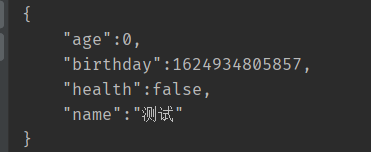淺談Java中FastJson的使用
使用maven導入依賴包
<!--下邊依賴跟aop沒關系,只是項目中用到了 JSONObject,所以引入fastjson--><dependency> <groupId>com.alibaba</groupId> <artifactId>fastjson</artifactId> <version>1.2.70</version></dependency>
常用方法:
1.JSON.toJSONString(obejct) - java對象轉JSON字符串,
注意:
默認情況下,如果int類型和boolean類型的屬性沒賦值的時候 (public boolean a; public int b;),調用 JSON.toJSONString(obejct) 序列化后,a和b不會被過濾掉,而是返回boolean類型和int類型的默認值 false和0。當然其他類型如果沒有賦值,序列化時,會被過濾掉。
來看下例子就明白了
public class Test { public static void main(String[] args) {List<User> userList = new ArrayList<>();User user = new User();user.setName('123');userList.add(user);System.out.println(JSON.toJSONString(userList)); } public static class User{private String name;private int age;public boolean health;public Date time; public String getName() { return name;} public void setName(String name) { this.name = name;} public int getAge() { return age;} public void setAge(int age) { this.age = age;} }}
先給name賦值,其他的都不賦值,結果time屬性被過濾掉了,如下:

再看下都不賦值的情況,結果name和time屬性都被過濾掉了,而int類型的age和boolean類型的health屬性取得時類型的默認值:

2.JSON.parseObject(string, User.class) - JSON字符串轉java對象
(1)List集合轉JSON
@RestControllerpublic class Json { @RequestMapping(value = '/json') public String json() throws Exception{List<User> userList = new ArrayList<>();userList.add(new User('1', '1', 20));String res = JSON.toJSONString(userList);return res; }}

(2)Map集合轉JSON
package com.lxc.Test; import com.alibaba.fastjson.JSON; import java.util.ArrayList;import java.util.HashMap;import java.util.List;import java.util.Map; public class Json { public static void main(String[] args) {Map<String, Object> userList = new HashMap<>();for(int i = 0; i < 5; i ++) { userList.put('user'+i, new User('name'+i, 20+i));}System.out.println('json:'+JSON.toJSONString(userList)); } public static class User{private String name;private int age; public User(String name, int age) { this.name = name; this.age = age;} public String getName() { return name;} public void setName(String name) { this.name = name;} public int getAge() { return age;} public void setAge(int age) { this.age = age;} }}

1.JSON轉Java對象 - JSON.perseObject()
public class Json { public static void main(String[] args) {String json = '{'age':20,'name':'name0'}';System.out.println(JSON.parseObject(json, User.class)+''); }}

2.JSON轉Java集合 - JSON.perseArray()
public class Json { public static void main(String[] args) {String json = '[{'age':20,'name':'name0'}]';List<User> userList = JSON.parseArray(json, User.class);userList.forEach(System.out::println); }}

toJSONString 靜態方法參數有兩個:
參數一:要序列化的對象;參數二:SerializerFeature 枚舉類型的可變參數 ( 我們可以傳遞多個參數 ),進行序列化時,我們可以定義特殊的需求。

1.SerializerFeature.WriteMapNullValue
對一個對象或者列表進行序列化時,默認情況下如果屬性值為null,序列化后的結果會過濾掉其屬性,如果想保留其屬性值,可以使用 SerializerFeature.WriteMapNullValue。
public class Json { public static void main(String[] args) {User user = new User();user.setAge(20);String res = JSON.toJSONString(user, SerializerFeature.WriteMapNullValue);System.out.println(res); } public static class User{private String name = null;private int age; public String getName() { return name;} public void setName(String name) { this.name = name;} public int getAge() { return age;} public void setAge(int age) { this.age = age;} @Overridepublic String toString() { return 'User{' + 'name=’' + name + ’’’ + ', age=' + age + ’}’;} }}

2.SerializerFeature.WriteNullStringAsEmpty
對一個對象或者列表進行序列,把屬性值為null的字段進行轉化為 '' 雙引號。
public class Json { public static void main(String[] args) {User user = new User();user.setAge(20);String res = JSON.toJSONString(user, SerializerFeature.WriteNullStringAsEmpty);System.out.println(res); }}

3.SerializerFeature.WriteNullNumberAsZero
序列之后, 把屬性值為 null 的屬性轉化為 0,這個前提是此屬性是 int 類型的!
public class Json { public static void main(String[] args) {User user = new User();user.setName('測試');String res = JSON.toJSONString(user, SerializerFeature.WriteNullNumberAsZero);System.out.println(res); }}

4.SerializerFeature.WriteNullBooleanAsFalse
序列之后, 把屬性值為 null 的屬性轉化為 false,這個前提是此屬性是 boolean 類型的!
@Datapublic class User{private String name;private int age;private boolean health;}

5.SerializerFeature.WriteDateUseDateFormat
把時間戳序列化為正常的時間,默認輸出JSON.toJSONString() 序列之后, 默認輸出如下:

添加 SerializerFeature.WriteDateUseDateFormat 之后的效果:

@Datapublic class User{ private String name; private int age; private Date birthday = new Date(); private boolean health;}
6.SerializerFeature.PrettyFormat
序列化的數據縱向布局。

在序列化時,進行個性定制!該注解的作用于方法上,字段上、參數上,可在序列化和反序列化時進行特性功能定制。

1.注解屬性 name序列化后的名字(單獨序列化,對屬性名進行修改)
@JSONField(name='username')private String name;

2.注解屬性 ordinal序列化后的順序(字段的排序)
@JSONField(ordinal = 1)private String name;@JSONField(ordinal = 2)private int age;

3.注解屬性 format 序列化后的格式
@JSONField(format = 'YYYY-MM-dd')private Date birthday = new Date();

4.注解屬性 serialize 是否序列化該字段(默認為true,如果false,當字段值為null時,會被過濾掉)
5.使用serializeUsing來定制屬性的序列化類

什么意思呢,類似vue中的過濾器,可以單獨訂制處理類下的某個屬性:
第一步:編寫一個類A,實現ObjectSerializer 接口;第二步:重寫write方法;第三步:在需要定制化的屬性上邊 添加注解,@JSONField(serializeUsing = A.class)
具體實現如下:
public class Json { public static void main(String[] args) {List<User> userList = new ArrayList<>();User user = new User();user.setName('測試,');userList.add(user);System.out.println(JSON.toJSONString(userList)); } public static class SerializeUsingFn implements ObjectSerializer { @Overridepublic void write(JSONSerializer jsonSerializer, Object fieldValue, Object fieldName, Type fieldType, int i) throws IOException { System.out.println(fieldValue); // 測試, System.out.println(fieldName); // name System.out.println(fieldType); // String System.out.println(i); // 0 String name = (String) fieldValue; // 向下轉型,獲取到age屬性值 String filterName = name + '呵呵'; // 這里可以對name屬性進行定制化 jsonSerializer.write(filterName); // 調用write方法} } public static class User{@JSONField(serializeUsing = SerializeUsingFn.class)private String name;private int age;public boolean health;public Date time; public String getName() { return name;} public void setName(String name) { this.name = name;} public int getAge() { return age;} public void setAge(int age) { this.age = age;} }}
可以看到name字段值 被修改了后邊添加了 '呵呵' 倆字。

只能作用在類上,也是對類里邊的字段進行序列化

@JSONType()注解中的屬性
· includes 要序列化的字段(注意:如果字段上有 @serialize(true),如果沒有includes字段也不會被序列化),它是一個數組,源碼如下:

@Data@JSONType(includes = {'name', 'age'})public class User{ private String name; private int age; private boolean health; private Date birthday = new Date();}

· orders序列化后的字段順序,也是一個數組,源碼如下:

@JSONType(includes = {'name','birthday', 'health', 'age'}, orders = {'age','name','birthday','health'})public static class User{ private String name; private int age; private boolean health; private Date birthday = new Date();}

過濾字段,通過 SimplePropertyPreFilter 過濾器,來過濾指定的屬性名,然后在轉JSON的時候,帶上過濾器參數即可。例如,把下邊屬性health 過濾掉:
// userList = [{'age':20,'health':true,'name':'測試,呵呵','time':'2021-06-29 09:40:55'}] SimplePropertyPreFilter filter = new SimplePropertyPreFilter();// 下邊方法也很好理解:調用過濾器上邊的getExcludes排除字段的方法,什么字段需要排除呢:add() 添加需要排除的字段即可filter.getExcludes().add('health');System.out.println(JSON.toJSONString(userList, filter));

當然,如果需要排除大量的字段,保留一個字段,可以使用:filter.getIncludes() .add('xxx') 方法,意思:只保留xxx屬性,其他的都會被過濾。
如果過濾或者添加多個字段,可以使用:addAll() 方法,參數必須是一個集合Collection 。

過濾多個字段:
SimplePropertyPreFilter filter = new SimplePropertyPreFilter();List<String> r = new ArrayList<>() { {add('health');add('name'); }};filter.getExcludes().addAll(r);System.out.println(JSON.toJSONString(userList, filter));

暫時就這么多,項目中用到別的方法在記錄!
到此這篇關于淺談Java中FastJson的使用的文章就介紹到這了,更多相關FastJson的使用內容請搜索好吧啦網以前的文章或繼續瀏覽下面的相關文章希望大家以后多多支持好吧啦網!
相關文章:

 網公網安備
網公網安備